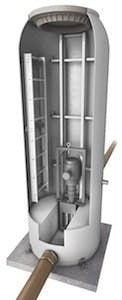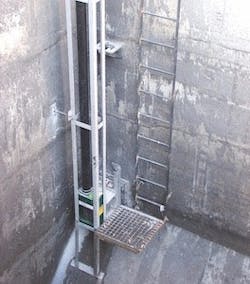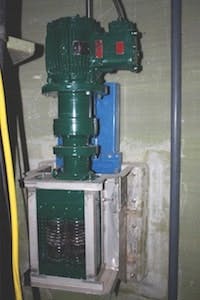One Stop Chop
It is just past 10 p.m. on Friday, and the phones start ringing in the pockets of the on-call collection systems operators. It is an alarm for another pump clog at one of the sewage lift stations—the second one this week. Does this situation sound familiar? Then it might be time to consider retrofitting a two-shafted grinder into the problem lift stations. The steps are simple: determine if your station is a candidate, learn how to navigate a retrofit, and understand the benefits a retrofit can offer.
1. Determine Retrofit Candidacy
“Every municipality is a candidate for a grinder retrofit, and every municipality has that problem pump station network,” said Troy Heimerl, director of municipal sales for JWC Environmental.
There are several qualifiers that can flag a station as an ideal candidate for a retrofit: an older lift station not designed for higher solids loading, outdated grinding equipment and, of course, recurring plugs in the pumps requiring manual cleaning. If these issues resonate, then the facility likely is a candidate for retrofitting with a two-shafted grinder.
“If a station has pumps plugging more than once a week, it’s absolutely time for a retrofit,” Heimerl said. “But the reality of it is unplugging a pump anytime is too much.” While operators may joke that the equipment always seems to fail on Fridays, Saturdays and Sundays, Heimerl concedes, “there’s a lot of truth to that. When the operators are away, the pumps always seem to fail.”
A grinder can offer the manager of a sewage collections network reassurance that things will keep moving smoothly day and night, weekends included. Two-shafted grinders can be retrofitted into the system ahead of the pumps to shred debris before it creates a clog.
Left: Grinding wipes with a grinder pump before they reach the pumps has shown to prevent damage in the pump system. Right: Many sewage lift stations in service today were not designed with the understanding that solids waste in wastewater would change and this high solids loading overwhelms traditional pumps.
2. Choosing a Grinder Pump
Many of the sewage lift stations in service today were not designed to deal with the high solids content found in today’s sewage. Heavy solids loading, often from disposable wipes, will easily overwhelm traditional pumps, including solids handling pumps. Typically, when operators find their pumps clogging and failing, it is due to wipes-related clogging.
“Sewage has changed, therefore the industry standard of the 3-in. spherical solid that pumps were designed to pass no longer meets today’s needs,” Heimerl said. “The addition of a grinder is really an insurance policy. It’s taking care of those items that shock operators when they show up in their sewer system. The addition of a grinder maximizes your pump station’s efficiency while curtailing overtime and unplanned maintenance costs.”
Grinding wipes with other waste before it gets to the pumps has shown to be an effective method for preventing damage, eliminating risks, and reducing the time and energy costs associated with clogging. “When a grinder is in place the wipes are shredded down small enough so they do not reweave, rope together or form cumbersome rag balls in the lift stations. They remain in suspension and can be pumped easily,” Heimerl said.
Left: Custom, stainless-steel mounting frames designed for specifc lift stations can account for space constraints, equipment, pumps and float switches. Right:Grinders, like this wall-mounted one, help improve station efficiency and reduce maintenance for operators.
3. Choose an Ideal Installation Point
In a perfect world, every grinder could be retrofitted within the influent pipe or channel to the lift station before sewage enters the wet well. “When the grinder can be upstream of the wet well, there aren’t any pumps to maneuver around, and it’s a cleaner environment,” Heimerl said.
In many cases, however, installing a grinder in the inlet is not possible. “If you’re retrofitting an older pump station, it is likely that no accommodations were considered in the design for installing a sewage grinder,” said Michael Wolf of JWC Environmental. “In a retrofit scenario, you can’t change the structure of the wet well, so you’re going to have to work around a few things inside the wet well.”
While space constraints are one of the major factors in a retrofit, grinders can be worked into nearly every station’s configuration. A common technique when retrofitting a grinder is to mount it to the wall of the lift station’s wet well in front of the influent pipe. When JWC Environmental installs a retrofit, its engineers design a customized stainless-steel mounting frame specific to the particulars of the lift station. The engineering process takes into account space constraints, other equipment like pumps and float switches in the wet well, and making the grinder accessible for easy inspection and service.
“If it’s a wet well mounted system, we need to work within the station’s confines,” said Wolf. “We can do that. It’s just a matter of setting expectations with the owner, so we know what’s optimal and what arrangements they’ll need to be aware of for the retrofit.”
It is important to recognize that a perfect station does not exist—both in terms of space and flow rates. “We design the grinder for average daily flow, which will do an excellent job 99% of the time,” Heimerl said. To prepare for the troublesome 1% flow that falls outside the daily average, Heimerl suggests an overflow bar rack, which serves as backup during heavy storm flow events. “Overflow bar racks are an excellent way to account for unexpected rain events without having to install an oversized grinder.”
Another scenario that can present itself is a lift station wet well that is too small for any additional equipment beyond the pumps. In these situations, a simple grinder vault can be added upstream of the wet well in the influent pipe. One option for this is a pre-fabricated fiberglass reinforced polyester manhole with a grinder already installed. These ready-to- install solutions minimize the engineering and construction costs while solving the problems at the pump stations.
Often when retrofitting, prior equipment components can be reused. If you are replacing an outdated grinder with upgraded technologies, the installation will take advantage of existing equipment. “If we’re replacing an older grinder, whether ours or a competitor’s, we would be able to utilize all of their components, such as existing frameworks and controls,” Heimerl said.
4. Create a Detailed Plan
Once the user has determined the pump station is in need of a retrofit and discussed the idea with an experienced representative, heed this advice from Wolf: “Take a deep breath.”
While the retrofit should be simple, pay attention to the details of the process. “Take good notes. Set clear expectations. Utilize a good pump service provider, and once the grinder is installed, follow the maintenance procedures,” Wolf said.
Wolf advises collections operators to ensure they are following along with every step of the retrofit. While planning the retrofit, it is important for operators to take notes about what flow expectations are being used in sizing the grinder and what type of equipment fits their budget so they can reference them later. It also is imperative that operators work with their suppliers to set clear expectations for the retrofit so there aren’t any surprises during the process.
Of course, it also is important to have a good relationship with a trusted supplier and to be aware of the maintenance required once the retrofit is complete. “While operators will still need to do the typical yearly maintenance on the grinder, the maintenance on the pump that the grinder is protecting decreases dramatically,” Wolf said.
5. Set Installation in Motion
Replacing a 25-year-old grinder from a defunct company or an older grinder incapable of grinding up wipes, or adding the first grinder to a lift station experiencing too many pump clogs are all common retrofitting situations. No matter the reason for the retrofit, the process follows a standard course.
“We take a look and see what size the inlet channel or pipe is. We check to see what flow rates the downstream pumps to be protected are rated for, and we make some sizing decisions based these inputs,” Wolf said. “Once we’ve sized the grinder, we’ll discuss options for flow rates that are above average, and often install an overflow bar rack to account for any unusual rain events. We also evaluate motor options, controls and unique site considerations.”
Once the strategy is finalized and the equipment is ready, the team will come in for installation. “The installation process is quick,” said Heimerl. “Often we’ll have the old piece swapped out and our Muffin Monster will be up and running in less than a day.”
And once that grinder is up and running, the lift station is on its way to reduced maintenance and improved operational efficiency.
“Every time a customer comes to us with a problem lift station and we retrofit in a grinder, the clogging problem is gone the day after installation,” Heimerl said. “It really is!”




